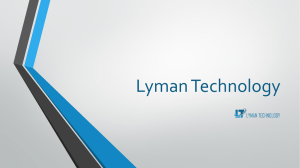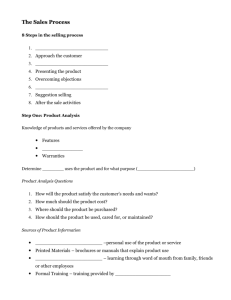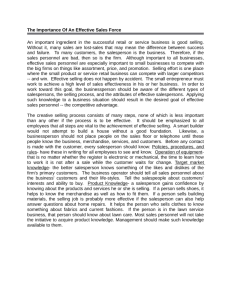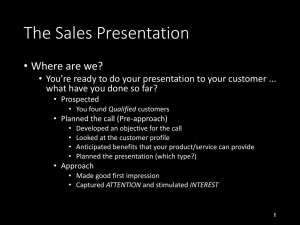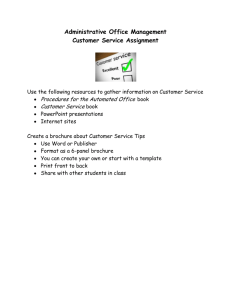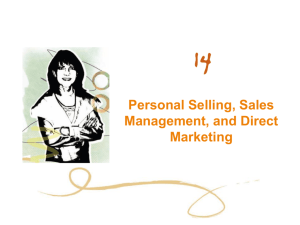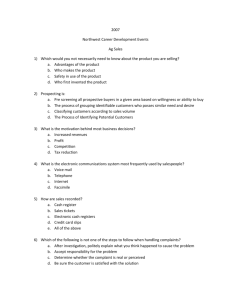Personal Selling and Customer service Notes Outline
advertisement
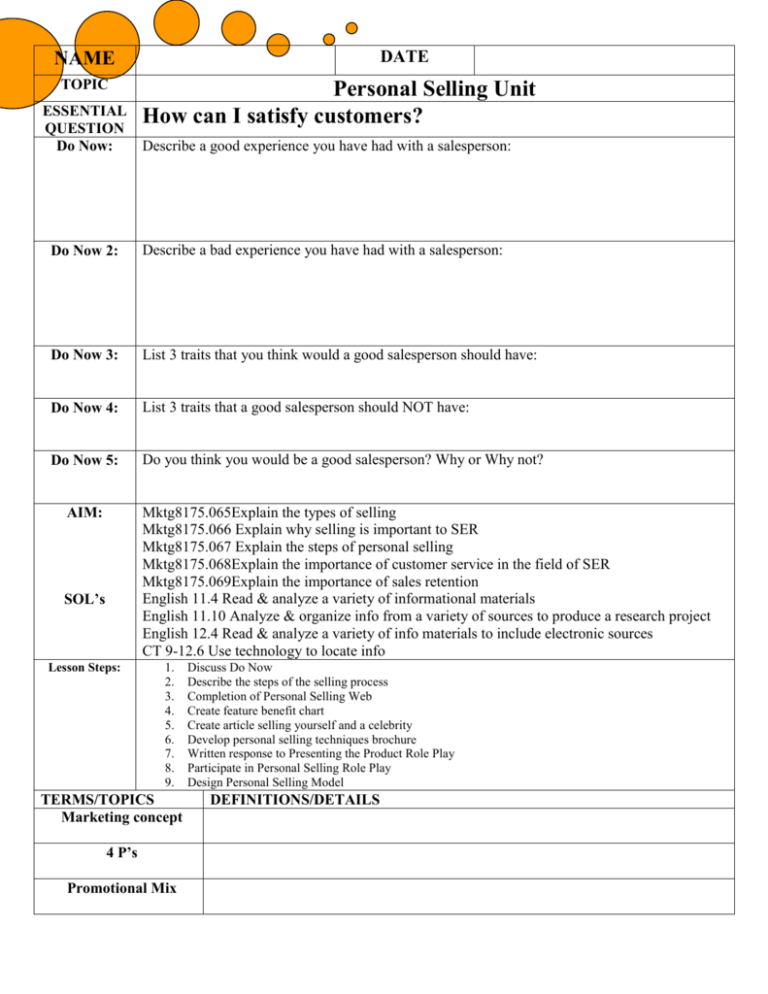
DATE NAME TOPIC ESSENTIAL QUESTION Do Now: Personal Selling Unit How can I satisfy customers? Describe a good experience you have had with a salesperson: Do Now 2: Describe a bad experience you have had with a salesperson: Do Now 3: List 3 traits that you think would a good salesperson should have: Do Now 4: List 3 traits that a good salesperson should NOT have: Do Now 5: Do you think you would be a good salesperson? Why or Why not? Mktg8175.065Explain the types of selling Mktg8175.066 Explain why selling is important to SER Mktg8175.067 Explain the steps of personal selling Mktg8175.068Explain the importance of customer service in the field of SER Mktg8175.069Explain the importance of sales retention English 11.4 Read & analyze a variety of informational materials English 11.10 Analyze & organize info from a variety of sources to produce a research project English 12.4 Read & analyze a variety of info materials to include electronic sources CT 9-12.6 Use technology to locate info AIM: SOL’s Lesson Steps: 1. 2. 3. 4. 5. 6. 7. 8. 9. TERMS/TOPICS Marketing concept 4 P’s Promotional Mix Discuss Do Now Describe the steps of the selling process Completion of Personal Selling Web Create feature benefit chart Create article selling yourself and a celebrity Develop personal selling techniques brochure Written response to Presenting the Product Role Play Participate in Personal Selling Role Play Design Personal Selling Model DEFINITIONS/DETAILS SATISFY CUSTOMERS Product, place, price, promotion Advertising, sales promotion, publicity, personal selling Selling Personal selling Satisfying customers by matching products to their wants and needs Any form of direct contact between a salesperson and a customer Importance of the Sales You represent the company Associate – Front Line 45% of customer say they are likely to spend more if the sales associate is helpful for the Company 18% of customers will walk out of a store it they don’t like the attitude of the sales associate Good business Satisfied customers are loyal customers who tell their friends, this increases sales Pre-approach Steps to take before walking on the sales floor Customer decisions Routine Limited Extensive Rational Motive Emotional Motive Pre-Approach Knowledge Product Info Store Info Company Info Industry Info 6 Steps of Selling Customers make different levels of buying decisions (subjective) No research involved, buy what they always buy – ex. Milk, toilet paper Some research involved – price comparisons, styles offered – ex. Stereo, clothing A lot of research involved – ex. House, car Conscious, factual reason for making a purchase – use for insurance, computers etc. Feelings of social approval, recognition, and prestige as reasons for making a purchase Things you need to know before trying to sell a product Features, benefits, materials, country of origin, # in stock, sizes available, etc. Hours open, where merchandise is located, who else is working, etc. Return policies, warranties, website info, who your target market is Who your competitors are, what is the going price Process of steps to sell anything – product, yourself, your ideas Greeting customer, Rules – w/in 30 secs, Eye contact, smile, not close ended question 1. Approach the customer If busy get let them know you will be with them in a second, Or get another associate to help 2. Needs determined Need to determine a customer needs (or wants) so that you can satisfy them Look for customers looking at certain products or picking up & holding products Observe Question Dead Ended vs. Open Ended Use who, what , where, when, how and why Fit products to customers by getting to know them Ask open-ended questions to get the customer talking Can I help you? How can I help you? Do you like read or green? What color do you prefer? Is that the brand you want? Why do you prefer that brand? Do you want preset controls? For whom are you shopping? Is it for a special occasion? What features are important to you? Looking for anything special? What are you looking for? Do you like 100 percent cotton? What kind of fabric do you like? Keep eye contact, give feedback, confirm details, be empathetic Listen If your store or dept doesn’t offer the product or service the customer needs Always suggest alternatives that you DO have 1st Refer somewhere Special order it Refer to a competitor – call ahead, give directions Tell which aisle or dept its in, call ahead to other sales person or escort them 3. Product Presentation Tips Feature Like show and tell Show no more than 3, medium price range, use laymans terms Product attributes or details, ex. XM radio in your car Advantages or personal benefit they will get from each feature Benefit Display/handle Demonstrate Sales aids Ex. You can get your favorite stations even when you are traveling Be creative – ex. Ask customer to touch the fabric or try on a coat Be dramatic – ex. Pour water on shoes to show water resistance Samples, newspaper articles, drawings, charts, warranty info, customer testimonial Do anything you can to get customer physically involved – test drive, taste, touch, Involving customer smell, etc. Friends, children, relatives, spouses Include the entire group Make small talk, provide a comfortable chair, offer a magazine or small toy THANKS T – thank the customer for bringing the problem to your attention H – hear the problem – listen carefully 4. objections handled A – apologize for the inconvenience the customer has experienced N – need more info, ask questions K – know a solution, and be prepared to propose it S – solve the problem, or find someone who can YOU take care of it 1. Do it YOURSELF - Show features of the warranty - Show how to upload picts - Pick up trash - Check on orders - Follow up with the manager - Look on website THANKS Tips 2. SATISFY the customer - Completely satisfy them - Do WHATEVER makes THEM happy - Don’t worry about sales/profit - Don’t worry about checking with manager - CUSTOMER is ALWAYS RIGHT (even when they are wrong or uniformed) 3. be Empathetic - sympathize with the customer - EVEN if they ARE wrong - They want you to UNDERSTAND them - They want you to LISTEN to them - They want you to APOLOGIZE for the WAY THINGS ARE – even if you had no control over it and it was SOMEONE ELSE’s fault - Have the right attitude - POSITIVE - Show energy and enthusiasm, not laziness 4. DON’T do nothing - Ask someone else to handle it - Check with the manager 1st Concerns, hesitations, doubts or honest reasons a customer has for not making a Objections purchase. Common ones – no need, don’t like particular product or store, wrong price or time Excuse 5. Close the Sale Buying signals Verbal Insincere reasons for not buying or not seeing the salesperson Obtaining positive agreement from the customer to buy. Don’t be afraid to ask The things customers do or say to indicate a readiness to buy “Oh, I like that” “That is exactly what I was looking for” “How can I pay for this?” Holding merchandise & smiling, taken it off a hanger and draped over their Non-Verbal arm/carrying it around with them Selling additional goods to the customer. Ex. Related merchandise, larger quantities, 6. Suggestive Selling sales, new items. Make the suggestion definite not optional. Ex. The manufacturer recommends this to take care of the product (give more examples of each – have kids give some) Referrals Getting names and information of other interested customers Ongoing communication with customers to prepare for future satisfying sales Ex. Take order/payment with courtesy – say name, reassure customer of choices, Relationship Building remind them how to get the best results, thank customers even when they don’t buy, check on shipment of items requested, call customers to let them know of delays or specials - ex. B. Moss, have customer surveys, start loyalty clubs Certification in Customer Service National Retail Federation What is it? 75 Multiple Choice questions Online, on computers like SOL Why take it? Can earn a verified credit (can be used to replace an SOL as a self selected verified credit for graduation) Looks great on your resume or application Take the 11 question NRF tutorial: https://www.castleworldwide.com/tds_v5/asp/nrf-demo.asp?userid=&package_id 1. write your answers here: 6. 2. 7. 3. 8. 4. 9. 5. 10. 11. Personal Selling 4 Types of Promotion Mix Personal Selling Customer Decision Making R L E R E Pre-Approach Pre-Approach Knowledge P S C I 6 Steps of Selling 1. O Q 2. D vs. L R T H A N K S Thanks Tips: Y 1.D 2. S 3. B 4. D O E O F B D D S I 3. 4. Buying Signals 5. V N 6. R R Feature Benefit Chart Directions: Pick 2 products of your choice from an then complete the information below using the guidelines from your notes *Note* expensive or complicated products are recommended so you will have plenty of features to describe Product 1 ___________________ (staple picture of product to back) Feature of Product Benefit of Product 1. 1. 2. 2. 3. 3. 4. 4. 5. 5. Creative Way to Present 1. 2. 2 Upgrades/Accessories to suggest when selling product: 1. 2. Product 2 ___________________ (staple picture of product to back) Feature of Product Benefit of Product 1. 1. 2. 2. 3. 3. 4. 4. 5. 5. 2 Upgrades/Accessories to suggest when selling product: 1. 2. Creative Way to Present 1. 2. SELLING YOURSELF, SELLING AN ATHLETE OR ENTERTAINER Write 2 articles for a newspaper or magazine starring yourself and a celebrity. To sell yourself, whether in business, to get a job or just making yourself memorable to people you meet, you need to create a personal story that sticks. One powerful way to create an instant story for yourself is to point out a failure that contrasts with whatever current success you have. Our natural tendency as humans is to hide our failings. We want to deny anything that doesn't fit in with our current perception of ourselves. However, what we find most interesting in other people is what they don't want us to know about them. For example, Jim Carrey slept in a van when he was growing up and Michael Jordan was cut from his high school basketball team. The more embarrassing the story, the better. The bigger the contrast between then and now, the better. Don't be angry about these failures, just smile when you talk about them. You've moved past them. They're part of your journey. Criteria: YOU Title Include your name & hook Graphic Picture of you or graphic relating to the story Paragraph Describe a past personal failure 1 Paragraph Describe a current personal 2 success Paragraph Conclusion 3 ATHLETE or ENTERTAINER Include their name & hook Picture of person or graphic relating to the story Do research to determine a past failure and describe it Do research to determine a current success and describe it conclusion *Differentiated option – write 2 songs including all of the above requirements Personal Selling Brochure Project Use your notes on personal selling and create an informative brochure in MS Publisher Directions: Open Microsoft Publisher Click on Publications for Print in the tab on the left side of the page Choose Brochures Click on the brochure design of your choice 3-Fold Brochure Format Guidelines Flap Back Cover 6 Steps of the Selling Your Name title Process – explained in your Class Period Picture/Graphic own words Date Picture/Graphic Inside Left Inside Center Inside Right Explanation and examples Picture/graphic Tips – Do’s and Don’ts of features Explanation and examples of benefits *Differentiated Option – Create a poster with all of the above information SELLING SPORTS & RECREATION MERCHANDISE Individual assignment: Write and TYPE a script for you and your customer using the scenario provided Situation: You are to assume the role of a sales associate at Sports Unlimited, you are responsible fore selling a variety of sports and recreation merchandise and related products. You know that it is important to use laymen’s terms, show how product features translate into customer benefits, involve the customer in the sale, demonstrate the product features and use sales aids. You also realize that during a product presentation it is common place to handle objections that may occur. Another sales associate who started with a customer must leave and has asked you to take over. He tells you that the consumer is a teenager who is entering high school next month and is planning on playing a fall sport. The customer is actually his mother who will be paying for the purchase. Your script must include ALL of the following steps: Pre-Approach – List info you know about the product List info you know about the customer/target market List the buying motive List the type of buying decision Approach – List a creative approach based on your knowledge and using your notes as a guideline Determine the situation Identify the need State the possible solutions (no more than 3) Presentation – Present solutions (no more than 3) Describe features and benefits to customers in a creative/interactive way Use suggestive selling to suggest upgrades or accessories Handle Objections – List anticipated objections Use a successful strategy to handle them Close the Sale – Recognize the buying signal Try to gain commitment with a closing technique Confirm choice Explain info needed to enjoy product Thank Follow-up *Differentiated option – draw a comic strip covering all of the above information Personal Selling Role Play You will be making a sales presentation to a peer. Note that your "product" need not be a tangible good. You may, for instance, attempt to obtain a donation to a worthy cause. You can be creative but BE REALISTIC. CRITERIA: Description Very Good BEFORE THE ROLE PLAY brochure/catalog Advertisement Pre-approach Approach Needs analysis Presentation/demo Handling objections Close Suggestion selling Referrals Create business card Include – your name, title, company name, address, phone #, email, related graphic or picture ROLE PLAY Use technique from notes Service, greeting, or merchandise Ask open ended questions Show benefits of feature Use technique from notes Feel/felt/found, or boomerang Use technique from notes Hold at register, choice, or summary At least 2 related items Attain at least 1 name Steps to make a business card – Open Microsoft Publisher Click on Publications for Print in the tab on the left side of the page Choose Business Cards Click on the business card design of your choice Ok Poor POINTS 10 10 10 10 10 10 10 10 10 10 Design a Model to represent the Steps of the Selling Process Examples – stair steps, pie chart, map, person, building, flowchart, poster, rap, sculpture, play, cell phone, sneaker, flower, snowflakes, clock, timeline, tree w/ ornaments, 6 sided dice, ocean w/ six boats, etc. Criteria – Professionalism – planned, organized and created w/ computer or professionally done by hand Creativity – unique and well thought out Details – shows and explains ALL steps of the process TOTAL PTS POSSIBLE 30 10 60 100

